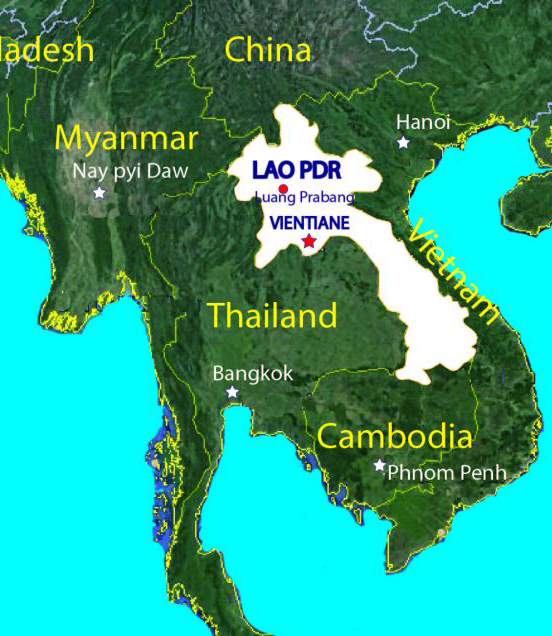The natural beauty, warm, friendly people and lack of rampant commercialism seen in other parts of Southeast Asia mean there’s no better time than now to book your ticket.
Learn more about ticking this off your bucket list!
Why you should travel to Laos now
Laos is the most relaxed country in Asia. We absolutely loved the slower lifestyle of this country: the feeling of disconnect from the hustle and bustle of the rest of the world while enjoying stellar views and fresh, delicious food. Laos is a country that combines some of the best elements of Southeast Asia in one bite-sized destination.
Travellers often make for Thailand, Vietnam and Cambodia when heading to Southeast Asia; Laos gets overlooked. But there’s something very, very special about this country.
Those who get there enjoy the culture, food, warmth and sights without the hustle and bustle of tourist crowds found elsewhere in the region. Laos’ charm lies in its people and their wonderful, laid-back nature.
The oft-touted acronym for Laos PDR (People’s democratic republic) is “Please Don’t Rush”, and believe me, you can’t. Laos is a country where one needs time, and we did things at a very languid pace, as Laos demands. It is a destination ideal for those travellers who aren’t in a hurry.
But that is all about to change. This enchanted place, with its gentle, waterborne tempo, fresh, flavourful food, delightful, easy-going people, and relatively low influx of tourists, is about to get a direct line to the most populous country in the world. The impact is going to be huge.
Where is Laos?
Laos is the only landlocked country in Southeast Asia. It is around the same size as New Zealand. Laos is 236,800 sq km, while New Zealand is approximately 268,838 sq km and Laos has a population of 6.8 million. It is surrounded by Myanmar, Cambodia, China, Thailand and Vietnam. Starting in China and finishing in southern Vietnam, the mighty Mekong runs the entire length of the country and makes up most of the border with Thailand, and the entire border with Myanmar.
Getting to Laos?
For us, Laos was an easy 3-hour flight from Singapore, and we had no overnight stays en route. There are regular flights from Thailand and Vietnam, and buses from Cambodia. You can also travel overland by train from Thailand or by boat. From Chiang Mai in Thailand, you can take a bus to the Thai and Laos border town of Houay Xai and cruise on the Mekong to Luang Prabang.

A bit of background
Laos has some 160 ethnic groups, depending on who you ask. It has been a staging area for imperial ambitions from the 12th-century Khmers to the anti-communist efforts of the United States. Modern-day Laos has its roots in the ancient Lao kingdom of Lan Xang, which was established in the 14th century and reached into present-day Cambodia and Thailand. Laos came under the domination of Siam (Thailand) from the late 18th century until the late 19th century, when it became part of French Indochina until 1953.
The ensuing power struggle between royalists and the communist group Pathet Lao from 1953 saw the country caught up in the Vietnam War. Communist forces overthrew the King in 1975, ending a six-century-old monarchy. They instituted a strict socialist regime and years of isolation. A gradual, limited return to private enterprise and the liberalisation of foreign investment laws began in 1988.
Now, a few kilometres north of Luang Prabang, a giant construction site heralds the arrival of a train line. It will run from southern China to Vientiane, the Laotian capital, and Thailand, with an eight-lane highway running parallel.
Languid Luang Prabang

We flew into Luang Prabang, a UNESCO World Heritage site surrounded by mountains and situated on a peninsula where the Mekong and Nam Khan rivers meet. This northern town, and former capital, is an absolute must for anyone visiting the country. It’s renowned for its rich cultural heritage and well-preserved architecture, from dazzling Buddhist temples to French colonial buildings. Luang Prabang has outrageous sunsets, phenomenal food in the restaurants and bars that line the Mekong, uncrowded night markets where the vendors do not hassle you, inexpensive traditional massages and loads of available daytrips and activities. Choose from caves, waterfalls, kayaking, biking, boat trips, elephant sanctuaries and cooking classes.
From boutiques and upscale hotels to hostels and guesthouses, there are accommodation options for all budgets. We stayed there for 6 nights of our 3-week trip.
Change is afoot
The high-speed rail link to China is going to bring rapid change. The railway will cater to a 160km/h passenger service and a 120km/hr freight service.
The railway is one of a number of multi-billion-dollar projects underway in the country that the Chinese are funding. Along the Nam Ou River just up from Luang Prabang, four dam projects are carving up the idyllic landscape. The projects will cause the resettlement of hundreds of villages and the destruction of areas of natural beauty.
Once the US$6 billion Laos-China Railway opens, the number of visitors could skyrocket. Fears are that the ensuing tourism boom could overwhelm Luang Prabang’s hospitality infrastructure and population of less than 450,000.

